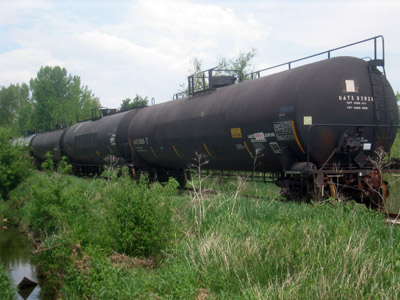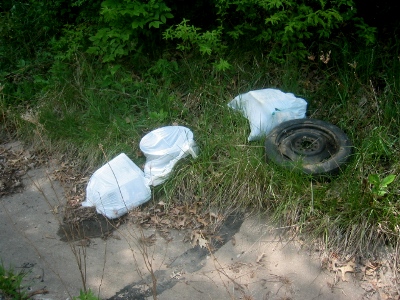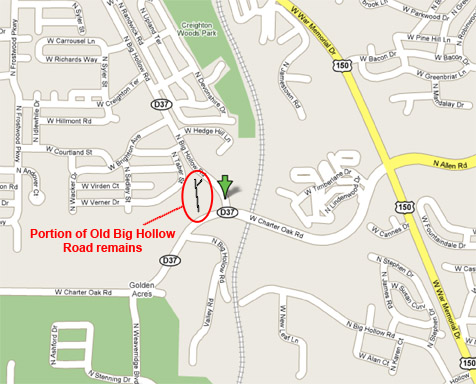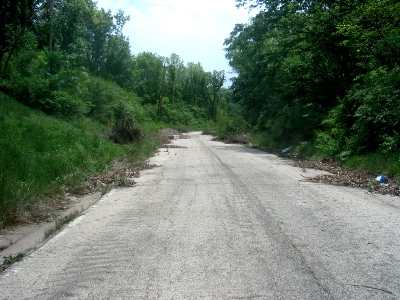The city hired Central Illinois Railroad to provide rail service to Pioneer Park over the new $2-million western connection. But prices were so high over that connection that it was actually cheaper to truck materials than bring them in by rail, which is probably why the western spur (the portion of the rail line that has been there for decades before it was recently connected to the Kellar Branch) was never successful, but the Kellar Branch was.
However, the western connection has started being used again. Central Illinois Railroad (CIRY) recently lost a contract up in Elk Grove Village to operate trackage in Centex Industrial Park. So the speculation is that the tank cars CIRY had been storing up there are the ones they recently moved down here. David Jordan reported on this on his transportation blog here and here.
That prompted a most interesting discussion at the May 8 city council meeting. Here’s how it was recorded in the official minutes (emphasis added), interspersed with my comments:
Council Member Sandberg referred to the storage of rail cars on the Keller Branch Railroad and he questioned if Central Illinois Rail had an agreement with the City to store any rail cars on the Keller Branch.
Sandberg is referring to these cars, parked on the Kellar Branch by Chanute Road:
Corporation Counsel Randy Ray said the City did not have an agreement with Central Illinois Rail on the Keller Branch south of Pioneer Parkway. He said the City had an agreement from the west with D.O.T. that would give them trackage rights to serve from the west and from the west would include that area in Pioneer Park. He explained the agreement did not specifically allow for the storage of cars, but it did not prohibit the practice either. He said, it was his understanding, as long as the storage of cars did not interfere with service, the practice would be allowed.
It’s interesting that he mentioned the agreement the city has is with “D.O.T.” — actually it’s called “DOT Rail Services,” and that company no longer owns Central Illinois Railroad. They sold off CIRY to a newly formed entity called “Central Illinois Railroad Holdings, LLC.” So, there is some question over whether that agreement is still in effect, since Article 12 states that DOT cannot “transfer, assign or convey the rights granted hereunder without the written consent of the CITY and only upon the condition that the assignee shall abide by all terms, conditions and agreements hereof.”
But assuming the contract is still valid, Article 5.5 states clearly that, “The movement of engines, cars and trains of the DOT on said tracks shall be performed pursuant to federal, state and local government laws and regulations.” The City’s municipal code requires that hazardous materials be reported to the Fire Marshal, and depending on what materials are in the tank cars and how much material is in them, there may be permits or licenses that need to be purchased. None of that was done.
Corporation Counsel Ray said, much like the agreement with D.O.T.’s predecessor, the agreement was silent to specific storage. He said there were other regulations that prohibited storing large amounts of hazardous waste or materials, for example. In response to a question from Council Member Sandberg, he added Central Illinois Rail did not request permission from the City to store cars on the rail, nor did they provide advance notice.
Isn’t the Sierra Club and Peoria Families Against Toxic Waste strangely silent on this issue? I mean, the tank cars are right next to the trail. Why aren’t there any complaints about this hazard to public health and safety? I would think they’d be all over it.
City Manager Randy Oliver said an opinion from the rail attorney was received and he advised, if a car was passing through the City of Peoria, the City would not have the right to make an inspection. He stated if a rail car was stored on the track, the City would have the right to inspect the rail car. He said he would request Fire Chief Kent Tomblin and his team to make an inspection of the cars to determine what was being stored, if anything. He added a fee would be charged for the inspection, if it was provided for under an Ordinance and if the rail attorney determined a fee was chargeable.
In discussion with Council Member Nichting regarding if the City would be able to recover a viable amount based on the City’s investment in the rail due to the allowance of real estate law’s 12% rate of return, Corporation Counsel Randy Ray agreed and he said he would work on reaching an agreement that would provide such a return.
Following further discussion, Council Member Sandberg discussed safety issues and he said he agreed with Council Member Nichting’s comments.
Now we’re talking. Inspect the cars and charge any and all applicable fees. I wonder if there will be a report back on this item at tomorrow’s council meeting. I can’t wait to hear.
It’s a little galling that CIRY won’t provide service over the Kellar Branch (which is still active until the Surface Transportation Board says otherwise) and can’t provide competitive service over the western connection for our local Peoria business, but it can use the trackage for some out-of-town company’s hazardous materials storage. We, the taxpayers, did not build that $2-million western connection for this purpose.

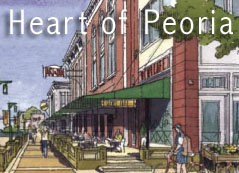 On June 15, four areas of Peoria will be the first to benefit from a new kind of zoning (some might even call it an alternative to zoning): form-based codes. The City Council last night unanimously adopted ordinances that put the new coding into place for the four form districts which are the West Main corridor, Warehouse District, Sheridan/Loucks Triangle, and Prospect Road corridor.
On June 15, four areas of Peoria will be the first to benefit from a new kind of zoning (some might even call it an alternative to zoning): form-based codes. The City Council last night unanimously adopted ordinances that put the new coding into place for the four form districts which are the West Main corridor, Warehouse District, Sheridan/Loucks Triangle, and Prospect Road corridor. One has to wonder how District 150 is estimating the cost to build a new school.
One has to wonder how District 150 is estimating the cost to build a new school. This morning as I listened to WCBU’s news broadcast, I was shocked to hear Ray LaHood say that Amtrak is never going to come to Peoria and we should be satisfied with bus service to Galesburg and/or Bloomington to connect with Amtrak there.
This morning as I listened to WCBU’s news broadcast, I was shocked to hear Ray LaHood say that Amtrak is never going to come to Peoria and we should be satisfied with bus service to Galesburg and/or Bloomington to connect with Amtrak there.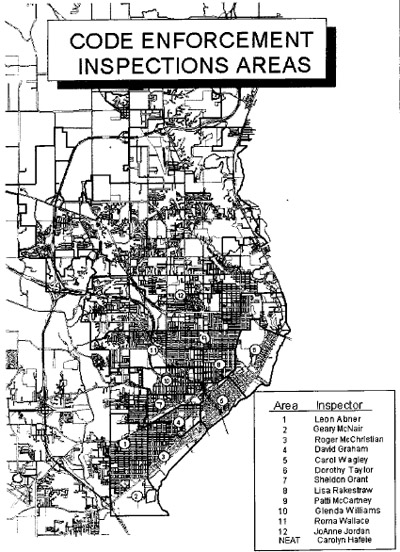
 I’ll be a guest on WHOI’s 5 p.m. newscast tonight. That’s channel 19 for those of you with rabbit ears, and channel 8 for those of you with Insight cable. I have no idea what we’ll be discussing, so it should be candid. I also hear it will be “interactive,” so maybe they’ll have some way of including viewers in the discussion. Tune in to find out.
I’ll be a guest on WHOI’s 5 p.m. newscast tonight. That’s channel 19 for those of you with rabbit ears, and channel 8 for those of you with Insight cable. I have no idea what we’ll be discussing, so it should be candid. I also hear it will be “interactive,” so maybe they’ll have some way of including viewers in the discussion. Tune in to find out.